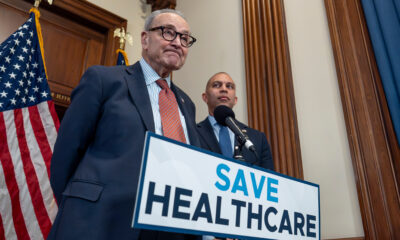Technology
USC Revamps Pharmacy Desert Tool to Combat Drugstore Closures

The University of Southern California (USC) has launched an updated version of its pharmacy desert mapping tool in response to a significant increase in pharmacy closures across the United States. This revamped platform allows users to examine neighborhood-specific pharmacy data over multiple years, helping to identify areas where local pharmacies are disappearing and thus threatening public access to essential medications.
The tool’s redesign comes at a critical time, as pharmacy closures have accelerated, jeopardizing access to vital medications such as insulin, antibiotics, and contraceptives. According to Dima Mazen Qato, a researcher at USC, “Pharmacies are a vital part of the health care landscape, but we’re seeing more closures every day. Ensuring that pharmacies remain accessible—particularly in neighborhoods that need them most—is crucial for promoting health equity.”
Pharmacy deserts, defined as regions with limited pharmacy access, create significant barriers for residents. Currently, approximately 1 in 8 neighborhoods in the United States lack convenient access to pharmacy services. This often leads to individuals having to take time off work to pick up medications or, worse, skipping doses entirely. A study led by Qato revealed that the decline in the number of pharmacies began in 2018, primarily due to industry consolidation. Major chains like CVS, Rite Aid, and Walgreens have closed hundreds of locations, while independent pharmacies also face high closure rates.
Pharmacy closures are exacerbated by the merging of large pharmacy chains with dominant pharmacy benefit managers (PBMs), which negotiate prescription drug benefits and often direct patients to preferred pharmacies. Douglas Hoey, CEO of the National Community Pharmacists Association, emphasized the importance of local pharmacies: “When you lose your local pharmacy, you lose more than a place to fill prescriptions—you lose a trusted health advisor, a medication safety expert and often the most accessible health care provider in the community.”
Enhancing Visibility for Better Access
The pharmacy desert mapping tool, originally launched in 2022, is a collaborative project involving the USC Alfred E. Mann School of Pharmacy and Pharmaceutical Sciences, the USC Dornsife College of Letters, Arts and Sciences, and various industry organizations. Qato, who holds the Hygeia Centennial Chair and is an associate professor at USC Mann, collaborated with Associate Professor Robert Vos and doctoral candidate Jeffrey Rozelle from the Spatial Sciences Institute to develop this tool.
The updated version has been utilized by health departments at both county and state levels to assess the implications of pharmacy closures and to support the establishment of new publicly funded pharmacy models. It has also been referenced by the Federal Trade Commission and attorney general offices nationwide to gain insights into local and state-level pharmacy access trends. Notably, USC Mann used the tool to identify a location for a community pharmacy in South Los Angeles, scheduled to open in March 2024. This site, located near the intersection of Slauson Avenue and Crenshaw Boulevard, became a pharmacy shortage area following the closure of a Rite Aid.
The new platform allows users to create accounts and zoom into specific neighborhoods to view historical data on pharmacy openings and closures. Features include symbols that indicate whether a pharmacy’s closure would exacerbate an existing shortage. “We thought carefully about who would use the tool—federal, state and local policymakers—to inform policies around pharmacies and created features they need,” Vos explained.
Rozelle added, “The tool is actively maintained, and there are a number of features and metrics we aim to release to the public as they become ready.” It defines pharmacy shortage areas based on scientifically derived distance thresholds to the nearest pharmacy, providing a clearer picture of access issues.
Ultimately, Qato emphasized the goal of this initiative: “Our aim is to make pharmacy access visible and actionable, so that policymakers, health departments, and advocates can identify where interventions are most needed and work to ensure that every community has access to the essential medicines people rely on.”
The revitalization of the pharmacy desert mapping tool represents a crucial step in addressing the growing issue of pharmacy access, particularly in communities that face systemic barriers to healthcare. As pharmacy closures continue to rise, the importance of tools that can guide policy and support public health becomes increasingly clear.
-

 Technology5 months ago
Technology5 months agoDiscover the Top 10 Calorie Counting Apps of 2025
-

 Technology2 weeks ago
Technology2 weeks agoOpenAI to Implement Age Verification for ChatGPT by December 2025
-

 Health3 months ago
Health3 months agoBella Hadid Shares Health Update After Treatment for Lyme Disease
-

 Health3 months ago
Health3 months agoAnalysts Project Stronger Growth for Apple’s iPhone 17 Lineup
-

 Health3 months ago
Health3 months agoErin Bates Shares Recovery Update Following Sepsis Complications
-

 Technology5 months ago
Technology5 months agoDiscover How to Reverse Image Search Using ChatGPT Effortlessly
-

 Technology3 months ago
Technology3 months agoElectric Moto Influencer Surronster Arrested in Tijuana
-

 Technology2 months ago
Technology2 months agoDiscover 2025’s Top GPUs for Exceptional 4K Gaming Performance
-

 Technology5 months ago
Technology5 months agoMeta Initiates $60B AI Data Center Expansion, Starting in Ohio
-

 Technology5 months ago
Technology5 months agoRecovering a Suspended TikTok Account: A Step-by-Step Guide
-

 Health5 months ago
Health5 months agoTested: Rab Firewall Mountain Jacket Survives Harsh Conditions
-

 Lifestyle5 months ago
Lifestyle5 months agoBelton Family Reunites After Daughter Survives Hill Country Floods





















